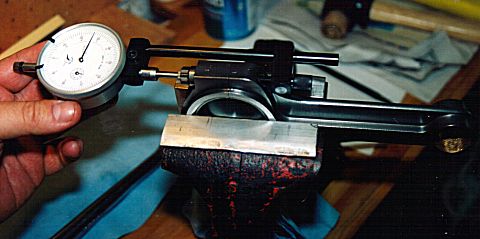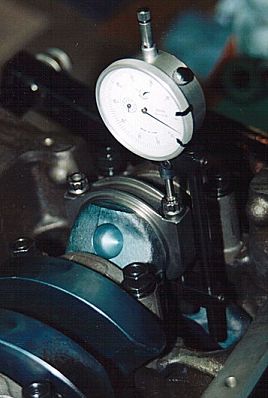| As was mentioned earlier, the rod bolts are probably the single most important fasteners in an engine. Thus the pre-load value attained on the rod bolts is especially critical. The whole idea behind "torquing" a fastener is to arrive at a certain level of pre-load. Of course the torque required to tighten a bolt has little to do with pre-load, but over time engineers have developed correlations to relate the two. So if it is known that a certain bolt will require a specific pre-load during operation then it can be deduced what torque value will yield this pre-load. |

|
|
The problem is that the correlation between torque and pre-load really only applies when the bolt is installed under the same conditions as were present when the correlation was developed. More simply; friction in the threads of the bolt can greatly affect the torque that is required in order to achieve the correct pre-load. Thus it is critical when torquing a fastener that you use the same thread lubricant as was used when the engineers determined the proper torque to pre-load correlation. And this is not always an easy thing to do. But there is a way that the pre-load on a bolt can be measured much more directly and this is by measuring how much the bolts stretches from its relaxed state when it is tightened. Ideally all fasteners would be installed using the stretch method, but it is not always convenient. Certainly in aerospace, any critical fasteners are always tightened by measuring stretch. Fortunately for us in the automotive world, rod bolts are also easy to tighten while measuring stretch. There are special gauges which are designed expressly for this purpose. Such a gauge is shown in use both in the top picture, and the one below. I bought this particular gauge from Summit Racing and it cost about $140. |
 Pauter recommended that the ARP rod bolts be torqued to 50 ft.lbs.
I asked Brian Pauter what the p/n was for the
ARP bolts that they use in their rods. The bolts are:
Pauter recommended that the ARP rod bolts be torqued to 50 ft.lbs.
I asked Brian Pauter what the p/n was for the
ARP bolts that they use in their rods. The bolts are:
(p/n 200-6207) ARP torque spec. = 45 ft. lbs I looked these bolts up in the ARP catalogue, which has tables of recommended stretch values for all of their rod bolts. For this bolt the value is: The way that you use a stretch gauge when tightening a bolt is as follows: Tighten the bolt a small amount, measure the stretch, tighten the bolt some more, measure the stretch, tighten the bolt some more, measure the stretch... This could take a while. So I decided to circumvent the process a bit on my first try, while I was tightening the rod bolts on the bench (in preparation for measuring the bearing clearance). I simply torqued the rod bolts to the Pauter recommended 50 ft.lbs. (in three increments, not all at once) and measured the resulting stretch. As it turns out this gave me just a little less then the required 0.0060" of stretch. With a little trial and error I determined that torquing the rod bolts to 55 ft.lbs. (with a recently calibrated torque wrench) would yield a fairly consistent stretch value of 0.0060" when using light machine oil on the threads. Thus the stretch gauge ended up being used primarily as a "correlation development" tool and also as a final check on the pre-load. Especially on final assembly it was nice to know that the rod bolts were tightened just right. It gives me peace of mind. I would personally not rebuild an engine without using a stretch gauge to check the pre-load on the rod bolts. E30 M3 owner Greg Dean points out that a better correlation can be developed between bolt preload and the number of turns that you tighten it. I did not try this but it makes perfect sense. Using the thread pitch it is quite easy to calculate how far a bolt stretches for each full turn applied by a wrench. You could probably get pretty darned close to the correct preload value just on paper. Then the stretch gauge could be used to ensure that the proper value was achieved. This takes the whole friction issue out of the picture. Thanks for the tip Greg. |
|
|